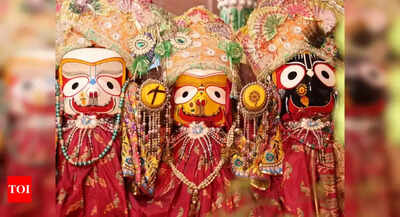ARTICLE AD BOX

Snana Purnima 2025: Today, on June 11, 2025, Puri, Odisha, is celebrating the holy festival of Snana Purnima with immense fervor and enthusiasm. The Jagannath Temple is hosting the ceremonial Snana Yatra of the holy trinity—Lord Jagannath, Lord Balabhadra, and Goddess Subhadra—on this auspicious day.
Jagannath Rath Yatra celebrations begin with this customary ceremony.
Snana Purnima 2025: Date and Time
Purnima Tithi Begins - June 10, 2025 - 11:35 AMPurnima Tithi Ends - June 11, 2025 - 01:13 PMShukla Purnima Moonrise on Purnima - June 10, 2025 - 06:44 PM
Snana Purnima 2025: Significance
The Snana Yatra is an annual bathing festival that takes place on Purnima (the full moon day) in the month of Jyeshtha according to the Hindu calendar. On this occasion, devotees receive their first chance to have darshan of Lord Jagannath and receive his divine siblings at the Snana Mandap located within the sanctum of Shree Jagannath Temple.During Snana Purnima, a ceremonial bath is performed for Lord Jagannath, Lord Balabhadra, and Devi Subhadra. Furthermore, the Snana Yatra is also organized on this day and during this Yatra, the three deities, along with Sudarshan, come out from their sanctum to the Snana Mandap, which is positioned at Ananda Bazar within the temple complex. Mahaprabhu Jagannath is acknowledged as the lord of the universe, who is known as Lord Krishna, along with his brother Balarama and sister Subhadra.
The term Jagannatha is quite descriptive, meaning the Natha of Jagat or God of the Universe.
Snana Purnima 2025: Puja Rituals
1. According to the Skanda Purana, King Indradyumna is credited with establishing the temple at Puri, where he placed all three deities along with Sudarshan. He was also the first one to give them bathe.2. During the Snana Yatra, the deities receive a ceremonial bath accompanied by the chanting of Vedic Mantras, the blowing of conch shells, and kirtans.3. The priests perform the bathing ritual using 108 pitchers filled with water sourced from the well located at the Sitala temple near Lord Jagannath Temple.4. Following the bath, the deities are adorned in the Gajanana (elephant) or Ganesha Besha, and their daily food offering, known as Bhogalagi, is prepared at the Snana Mandap.5. After the Snana Yatra, the three deities are kept out of public sight for a period of 15 days, referred to as the ‘Anasara’ period.
It is widely believed that the deities develop a fever after the ritual bath, which is why they do not return to the sanctorum.6. Throughout this period, the deities are provided only with fruits and water, along with medicines (Dasamula) supplied by Raj Vaidya, the royal physician.7. The deities are repainted with fresh colors during this time.8. The daily rituals of the temple are temporarily suspended during this period.9. On the 16th day, once the deities recover from their illness and regain their health, a festival known as Netrotsava or Nava Joubana Utsav (the festival of evergreen youth) is celebrated.10. Following the celebration of this festival, devotees are permitted to enter the temple grounds and have darshan of the deities.Mantra
- Om Namo Bhagvate Vasudevaye..!!
- Nilachala Nivasaya Nityaya Paramatmane, Balabhadra Subhadrabhyam Jagannathaya Te Namah..!!
- Hare Ram Hare Ram Ram Ram Hare Hare Hare Krishna Hare Krishna Krishna Krishna Hare Hare..!!



.png)
.png)
.png)
















 1 day ago
6
1 day ago
6









 English (US) ·
English (US) ·